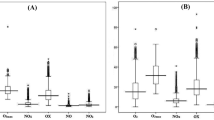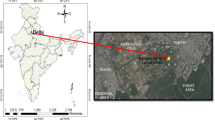A critical analysis has been made on the long-term yearly and seasonal variations of ozone concentration at Varanasi (25°N, 83°E), India and Halley Bay (76°S, 27°W), a British Antarctic Service Station. The effect of O3 depletion on night airglow emission of Li 6708 Å line at Varanasi and Halley Bay has been studied. Calculations based on chemical kinetics show that the airglow intensity of Li 6708 Å line has also been affected due to the depletion of O3 concentration. The yearly variations and seasonal variations of intensities of Li 6708 Å line for the above two stations are shown and compared. It has been shown that the rate of decrease of intensity of Li 6708 Å line was comparatively more at Halley Bay due to dramatic decrease of Antarctic O3 concentration.
Similar content being viewed by others
References
Balachandran S 1995 Lithium in first-ascent red giants; Memorie della Societa Astronomia Italiana 66 387–394.
Bhaumik D, Chakraborty J N, Midya S K and Chakraborty S 1996a Morning twilight airglow emission of lithium 6708 Å and OH (7, 2) band at Calcutta and their co-variation; Earth Moon Planets 75 169–175.
Bhaumik D, Chakraborty J N, Midya S K and Chakraborty S 1996b Evening twilight OH (7, 2) band emission at Calcutta and its covariation with Li 6708 Å; Earth Moon Planets 74 115–121.
Bodeker G E, Struthers H and Connor B G 2002 Dynamical containment of Antarctic ozone depletion; Geophys. Res. Lett. 29 14,206.
Bojkov R D 1992 Scientific assessment of ozone depletion; WMO Bull. 41 171.
Brown E F 1998 Implication of a subthreshold resonance for stellar beryllium depletion; Astrophys. J. 495 905–910.
Cordero E C and Nathan T R 2002 An examination of anomalously low column ozone in southern hemisphere mid-latitude during 1997; Geophys. Res. Lett. 29 1123, doi: 10.1029/2001GL013948.
Farman J C, Gardiner B G and Shanklin J D 1985 Large losses of total ozone in Antarctica reveal seasonal ClOx/ NOx interaction; Nature 315 207–210.
Jacchia L G 1977 SAO Special Report No. 375, Smithsonian Institution Astrophysical Observatory, Cambridge, Massachusetts.
Jana P K and Midya 1995 A theoretical model of altitudinal distribution of sodium atom; Earth Moon Planets 71 147–152.
Jana P K and Nandi S C 2005a Effect of solar parameters on Antarctic, artic and tropical ozone during the last solar cycle; Indian J. Radio Space Phys. 34 114–118.
Jana P K and Nandi S C 2005b Depletion of ozone and its effect on night airglow intensity of Na 5893 Å at New Delhi (29°N, 77°E) and Halley Bay (76°S, 27°W); Indian J. Phys. 79(11) 1313–1317.
Jana P K and Nandi S C 2005c Depletion of ozone and its effect on night airglow intensity of Na 5893 Å at Trivandrum (8.25°N, 76.9°E) and Halley Bay (76°S, 27°W); Mausam 57(2) 350–354.
Jana P K and Nandi S C 2006 Ozone decline and its effect on night airglow intensity of Na 5893 Å at Dumdum (22.5°N, 88.5°E) and Halley Bay (76°S, 27°W); J. Earth Syst. Sci. 115 607–613.
Jana P K, Midya S K and De U K 2001 Short-term ozone trend in India; Indian J. Radio Space Phys. 30 176–180.
Jana P K, Nandi S C and Sarkar D 2006 Depletion of ozone and its effect on night airglow intensity of Na 5893 Å at Srinagar and Halley Bay; Indian J. Radio Space Phys. 35 401–406.
Kerr A 1998 Deep chill triggers record ozone hole; Science 282 391.
Knauth D C, Federman S R, Lambert D L and Crane P 2000 Newly synthesized lithium in the interstellar medium; Nature 405 656–658.
Lemoine M, Vangioni-Flam E and Casse M 1998 Galactic cosmic rays and the evolution of light elements; Astrophys. J. 499 735–745.
Madrigal M A and Peraza J P 2005 Analysis of the evolution of the Antarctic ozone hole size; J. Geophys. Res. 110 D02107, doi: 10.1029/2004JD004944.
Meneguzzi M and Reeves H 1975 Light element production by cosmic rays; Astron. Astrophys. 40 99–110.
Meneguzzi M, Audouze J and Reeves H 1971 The production of the elements Li, Be, B by galactic cosmic rays in space and its relation with stellar observations; Astron. Astrophys. 15 337–359.
Midya S K 1994 Ozone decline and its effect on night airglow intensity of OH (8, 3) band; Earth Moon Planets 65 1–6.
Midya S K and Jana P K 2002 Atmospheric ozone depletion and its effect on environment; Indian J. Phys. 76B(2) 107–138.
Midya S K and Midya D 1993 The effect of Antarctic O3 decline on night airglow intensity of Na 5893 Å, O5577 Å, OH emissions and its correlation with solar flare numbers; Earth Moon Planets 61 175–182.
Midya S K, Sarkar H and Manna A 2001 Antarctic O3 depletion – its effect on the variation of Li 6708 Å emission line intensity at McMurdo and Halley Bay; Czech. J. Phys. 51 609–614.
Ramarty R, Kozlovsky B and Lingenfelter R E 1996 Light isotopes, extinct radioisotopes and gamma-ray lines from low energy cosmic-ray interactions; Astrophys. J. 456 525–540.
Read S M and Viola V E Jr 1984 Excitation functions for A≥6 fragments formed in 1H and 4He-induced reactions on light nucli; Atomic Data and Nuclear Data Tables 31(3) 359–397.
Reeves H, Fowler W A and Hoyle F 1970 Galactic cosmic ray origin of Li, Be and B in stars; Nature 226 727–729.
Salby M, Callaghan P, Keckhut P, Godin S and Guirlet M 2002 International changes of temperature and ozone, relationship between the lower and upper stratosphere; J. Geophys. Res. 107(D18), doi: 10.1029/2001JD000421.
Slanger T G, Cosby P C, Osterbrock D E, Stone R P S and Misch A A 2003 The high-resolution light-polluted night-sky spectrum at Mount Hamilton, California; PASP 115 869–878.
Taori A and Taylor M 2010 Dominant winter-time mesospheric wave signatures over a low latitude stations Hawaii (20.8°N): An investigation; J. Earth Syst. Sci. 119(3) 259–264, doi: 10.1007/S12040–010–0020.
Taori A, Makela J and Taylor M 2010 Mesospheric wave signatures and equatorial plasma bubbles: A case study; J. Geophys. Res. 115 A06302, doi: 10.1029/2009JA015088.
Uchino O, Bojkov R, Balis D S, Akagi K, Hayashi M and Kajihara R K 1999 Essential characteristics of the Antarctic spring ozone decline: Update to 1998; Geophys. Res. Lett. 26 1377–1380.
Vineeth C, Pant T K, Thampi S V, Sridharan R, Ravindram S, Devasia C V, Kumar K K and Alex S 2008 Investigation of the response of equatorial MLTI region during a partial solar eclipse through ground-based daytime optical technique; J. Geophys. Res. 113 A03302, doi: 10.1029/2007JA012335.
World Meteorological Organization (WMO) 2002 Scientific assessment of ozone depletion.
Author information
Authors and Affiliations
Corresponding author
Rights and permissions
About this article
Cite this article
JANA, P.K., SAHA, I. & MUKHOPADHYAY, S. Long-term ozone decline and its effect on night airglow intensity of Li 6708 Å at Varanasi (25°N, 83°E) and Halley Bay (76°S, 27°W). J Earth Syst Sci 120, 291–300 (2011). https://doi.org/10.1007/s12040-011-0047-8
Received:
Revised:
Accepted:
Published:
Issue Date:
DOI: https://doi.org/10.1007/s12040-011-0047-8




